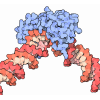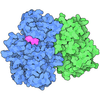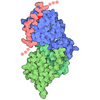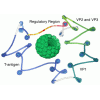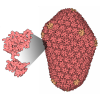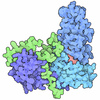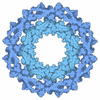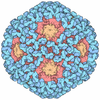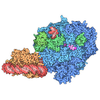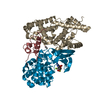+ Open data
Open data
- Basic information
Basic information
| Entry | Database: PDB / ID: 9i9i | ||||||||||||||||||||||||
|---|---|---|---|---|---|---|---|---|---|---|---|---|---|---|---|---|---|---|---|---|---|---|---|---|---|
| Title | Cryo-EM structure of CAK-CDK11 | ||||||||||||||||||||||||
 Components Components |
| ||||||||||||||||||||||||
 Keywords Keywords | TRANSFERASE / Complex / cell cycle / kinase | ||||||||||||||||||||||||
| Function / homology |  Function and homology information Function and homology informationRNA polymerase II CTD heptapeptide repeat S5 kinase activity / regulation of mRNA processing / ventricular system development / snRNA transcription by RNA polymerase II / regulation of centrosome cycle / CAK-ERCC2 complex / transcription factor TFIIK complex / adult heart development / transcription factor TFIIH core complex / transcription factor TFIIH holo complex ...RNA polymerase II CTD heptapeptide repeat S5 kinase activity / regulation of mRNA processing / ventricular system development / snRNA transcription by RNA polymerase II / regulation of centrosome cycle / CAK-ERCC2 complex / transcription factor TFIIK complex / adult heart development / transcription factor TFIIH core complex / transcription factor TFIIH holo complex / cyclin-dependent protein serine/threonine kinase activator activity / [RNA-polymerase]-subunit kinase / RNA Polymerase I Transcription Termination / cyclin-dependent protein serine/threonine kinase regulator activity / RNA Pol II CTD phosphorylation and interaction with CE during HIV infection / RNA Pol II CTD phosphorylation and interaction with CE / HIV Transcription Initiation / RNA Polymerase II HIV Promoter Escape / Transcription of the HIV genome / RNA Polymerase II Promoter Escape / RNA Polymerase II Transcription Pre-Initiation And Promoter Opening / RNA Polymerase II Transcription Initiation / RNA Polymerase II Transcription Initiation And Promoter Clearance / Formation of the Early Elongation Complex / Formation of the HIV-1 Early Elongation Complex / mRNA Capping / regulation of RNA splicing / RNA Polymerase I Transcription Initiation / regulation of G1/S transition of mitotic cell cycle / RNA polymerase II transcribes snRNA genes / cyclin-dependent kinase / ATP-dependent activity, acting on DNA / cyclin-dependent protein serine/threonine kinase activity / Tat-mediated elongation of the HIV-1 transcript / Formation of HIV-1 elongation complex containing HIV-1 Tat / Cyclin E associated events during G1/S transition / Formation of HIV elongation complex in the absence of HIV Tat / Cyclin A:Cdk2-associated events at S phase entry / Cyclin A/B1/B2 associated events during G2/M transition / cyclin-dependent protein kinase holoenzyme complex / RNA Polymerase II Transcription Elongation / Formation of RNA Pol II elongation complex / RNA Polymerase II Pre-transcription Events / positive regulation of smooth muscle cell proliferation / RNA polymerase II CTD heptapeptide repeat kinase activity / Recruitment of mitotic centrosome proteins and complexes / male germ cell nucleus / nucleotide-excision repair / TP53 Regulates Transcription of DNA Repair Genes / transcription initiation at RNA polymerase II promoter / regulation of cell growth / RNA Polymerase I Promoter Escape / G1/S transition of mitotic cell cycle / response to calcium ion / NoRC negatively regulates rRNA expression / Transcription-Coupled Nucleotide Excision Repair (TC-NER) / Formation of TC-NER Pre-Incision Complex / Formation of Incision Complex in GG-NER / fibrillar center / Dual incision in TC-NER / Gap-filling DNA repair synthesis and ligation in TC-NER / Cyclin D associated events in G1 / kinase activity / mitotic cell cycle / RUNX1 regulates transcription of genes involved in differentiation of HSCs / regulation of apoptotic process / transcription by RNA polymerase II / protein phosphorylation / protein kinase activity / regulation of cell cycle / protein stabilization / cell division / protein serine kinase activity / DNA repair / protein serine/threonine kinase activity / apoptotic process / regulation of DNA-templated transcription / regulation of transcription by RNA polymerase II / negative regulation of apoptotic process / perinuclear region of cytoplasm / positive regulation of transcription by RNA polymerase II / RNA binding / zinc ion binding / nucleoplasm / ATP binding / nucleus / plasma membrane / cytosol / cytoplasm Similarity search - Function | ||||||||||||||||||||||||
| Biological species |  Homo sapiens (human) Homo sapiens (human) | ||||||||||||||||||||||||
| Method | ELECTRON MICROSCOPY / single particle reconstruction / cryo EM / Resolution: 3.5 Å | ||||||||||||||||||||||||
 Authors Authors | Cushing, V.I. / Greber, B.J. / McGeoch, A.J.S. / Feng, J. | ||||||||||||||||||||||||
| Funding support |  United Kingdom, 2items United Kingdom, 2items
| ||||||||||||||||||||||||
 Citation Citation |  Journal: Science / Year: 2025 Journal: Science / Year: 2025Title: Structural basis of T-loop-independent recognition and activation of CDKs by the CDK-activating kinase. Authors: Victoria I Cushing / Amy J S McGeoch / Sophie L Williams / Theodoros I Roumeliotis / Junjie Feng / Lucy M Dan / Jyoti S Choudhary / Norman E Davey / Basil J Greber /  Abstract: Cyclin-dependent kinases (CDKs) are prototypical regulators of the cell cycle. The CDK-activating kinase (CAK) acts as a master regulator of CDK activity by catalyzing the activating phosphorylation ...Cyclin-dependent kinases (CDKs) are prototypical regulators of the cell cycle. The CDK-activating kinase (CAK) acts as a master regulator of CDK activity by catalyzing the activating phosphorylation of CDKs on a conserved threonine residue within the regulatory T-loop. However, structural data illuminating the mechanism by which the CAK recognizes and activates CDKs have remained elusive. In this study, we determined high-resolution structures of the CAK in complex with CDK2 and CDK2-cyclin A2 by cryogenic electron microscopy. Our structures reveal a T-loop-independent kinase-kinase interface with contributions from both kinase lobes. Computational analysis and structures of the CAK in complex with CDK1-cyclin B1 and CDK11 indicate that these structures represent the general architecture of CAK-CDK complexes. These results advance our mechanistic understanding of cell cycle regulation and kinase signaling cascades. | ||||||||||||||||||||||||
| History |
|
- Structure visualization
Structure visualization
| Structure viewer | Molecule:  Molmil Molmil Jmol/JSmol Jmol/JSmol |
|---|
- Downloads & links
Downloads & links
- Download
Download
| PDBx/mmCIF format |  9i9i.cif.gz 9i9i.cif.gz | 190.9 KB | Display |  PDBx/mmCIF format PDBx/mmCIF format |
|---|---|---|---|---|
| PDB format |  pdb9i9i.ent.gz pdb9i9i.ent.gz | 139.3 KB | Display |  PDB format PDB format |
| PDBx/mmJSON format |  9i9i.json.gz 9i9i.json.gz | Tree view |  PDBx/mmJSON format PDBx/mmJSON format | |
| Others |  Other downloads Other downloads |
-Validation report
| Summary document |  9i9i_validation.pdf.gz 9i9i_validation.pdf.gz | 1.5 MB | Display |  wwPDB validaton report wwPDB validaton report |
|---|---|---|---|---|
| Full document |  9i9i_full_validation.pdf.gz 9i9i_full_validation.pdf.gz | 1.5 MB | Display | |
| Data in XML |  9i9i_validation.xml.gz 9i9i_validation.xml.gz | 35 KB | Display | |
| Data in CIF |  9i9i_validation.cif.gz 9i9i_validation.cif.gz | 51.4 KB | Display | |
| Arichive directory |  https://data.pdbj.org/pub/pdb/validation_reports/i9/9i9i https://data.pdbj.org/pub/pdb/validation_reports/i9/9i9i ftp://data.pdbj.org/pub/pdb/validation_reports/i9/9i9i ftp://data.pdbj.org/pub/pdb/validation_reports/i9/9i9i | HTTPS FTP |
-Related structure data
| Related structure data |  52758MC  9i9jC  9i9kC  9qcvC  9qcxC  9skqC M: map data used to model this data C: citing same article ( |
|---|---|
| Similar structure data | Similarity search - Function & homology  F&H Search F&H Search |
- Links
Links
- Assembly
Assembly
| Deposited unit | 
|
|---|---|
| 1 |
|
- Components
Components
-Protein , 4 types, 4 molecules KHIJ
| #1: Protein | Mass: 49970.613 Da / Num. of mol.: 1 Source method: isolated from a genetically manipulated source Details: CDK11B (p58) / Source: (gene. exp.)  Homo sapiens (human) / Gene: CDK11B, CDC2L1, CDK11, PITSLREA, PK58 / Production host: Homo sapiens (human) / Gene: CDK11B, CDC2L1, CDK11, PITSLREA, PK58 / Production host:  Trichoplusia ni (cabbage looper) / References: UniProt: P21127, cyclin-dependent kinase Trichoplusia ni (cabbage looper) / References: UniProt: P21127, cyclin-dependent kinase |
|---|---|
| #2: Protein | Mass: 38132.340 Da / Num. of mol.: 1 Source method: isolated from a genetically manipulated source Source: (gene. exp.)  Homo sapiens (human) / Gene: MNAT1, CAP35, MAT1, RNF66 / Production host: Homo sapiens (human) / Gene: MNAT1, CAP35, MAT1, RNF66 / Production host:  Trichoplusia ni (cabbage looper) / References: UniProt: P51948 Trichoplusia ni (cabbage looper) / References: UniProt: P51948 |
| #3: Protein | Mass: 37721.508 Da / Num. of mol.: 1 Source method: isolated from a genetically manipulated source Source: (gene. exp.)  Homo sapiens (human) / Gene: CCNH / Production host: Homo sapiens (human) / Gene: CCNH / Production host:  Trichoplusia ni (cabbage looper) / References: UniProt: P51946 Trichoplusia ni (cabbage looper) / References: UniProt: P51946 |
| #4: Protein | Mass: 43651.070 Da / Num. of mol.: 1 Source method: isolated from a genetically manipulated source Source: (gene. exp.)  Homo sapiens (human) / Gene: CDK7, CAK, CAK1, CDKN7, MO15, STK1 / Production host: Homo sapiens (human) / Gene: CDK7, CAK, CAK1, CDKN7, MO15, STK1 / Production host:  References: UniProt: P50613, cyclin-dependent kinase, [RNA-polymerase]-subunit kinase |
-Non-polymers , 3 types, 5 molecules 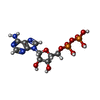

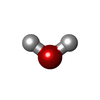


| #5: Chemical | | #6: Chemical | #7: Water | ChemComp-HOH / | |
|---|
-Details
| Has ligand of interest | N |
|---|---|
| Has protein modification | Y |
-Experimental details
-Experiment
| Experiment | Method: ELECTRON MICROSCOPY |
|---|---|
| EM experiment | Aggregation state: PARTICLE / 3D reconstruction method: single particle reconstruction |
- Sample preparation
Sample preparation
| Component |
| ||||||||||||||||||||||||||||
|---|---|---|---|---|---|---|---|---|---|---|---|---|---|---|---|---|---|---|---|---|---|---|---|---|---|---|---|---|---|
| Molecular weight |
| ||||||||||||||||||||||||||||
| Source (natural) |
| ||||||||||||||||||||||||||||
| Source (recombinant) |
| ||||||||||||||||||||||||||||
| Buffer solution | pH: 7.9 | ||||||||||||||||||||||||||||
| Buffer component |
| ||||||||||||||||||||||||||||
| Specimen | Conc.: 0.5 mg/ml / Embedding applied: NO / Shadowing applied: NO / Staining applied: NO / Vitrification applied: YES | ||||||||||||||||||||||||||||
| Specimen support | Grid material: GOLD / Grid mesh size: 300 divisions/in. / Grid type: UltrAuFoil R1.2/1.3 | ||||||||||||||||||||||||||||
| Vitrification | Instrument: FEI VITROBOT MARK IV / Cryogen name: ETHANE / Humidity: 100 % / Chamber temperature: 278 K |
- Electron microscopy imaging
Electron microscopy imaging
| Experimental equipment |  Model: Titan Krios / Image courtesy: FEI Company |
|---|---|
| Microscopy | Model: TFS KRIOS |
| Electron gun | Electron source:  FIELD EMISSION GUN / Accelerating voltage: 300 kV / Illumination mode: FLOOD BEAM FIELD EMISSION GUN / Accelerating voltage: 300 kV / Illumination mode: FLOOD BEAM |
| Electron lens | Mode: BRIGHT FIELD / Nominal magnification: 165000 X / Nominal defocus max: 2000 nm / Nominal defocus min: 700 nm / Cs: 2.7 mm |
| Specimen holder | Cryogen: NITROGEN / Specimen holder model: FEI TITAN KRIOS AUTOGRID HOLDER |
| Image recording | Electron dose: 70 e/Å2 / Film or detector model: GATAN K3 BIOQUANTUM (6k x 4k) / Num. of grids imaged: 1 / Num. of real images: 7049 |
| EM imaging optics | Energyfilter name: GIF Bioquantum |
- Processing
Processing
| EM software |
| ||||||||||||||||||||||||||||||||||||||||||||
|---|---|---|---|---|---|---|---|---|---|---|---|---|---|---|---|---|---|---|---|---|---|---|---|---|---|---|---|---|---|---|---|---|---|---|---|---|---|---|---|---|---|---|---|---|---|
| CTF correction | Type: PHASE FLIPPING AND AMPLITUDE CORRECTION | ||||||||||||||||||||||||||||||||||||||||||||
| 3D reconstruction | Resolution: 3.5 Å / Resolution method: FSC 0.143 CUT-OFF / Num. of particles: 31743 / Algorithm: FOURIER SPACE / Symmetry type: POINT | ||||||||||||||||||||||||||||||||||||||||||||
| Atomic model building | Protocol: RIGID BODY FIT / Space: REAL | ||||||||||||||||||||||||||||||||||||||||||||
| Atomic model building | 3D fitting-ID: 1
|
 Movie
Movie Controller
Controller









 PDBj
PDBj